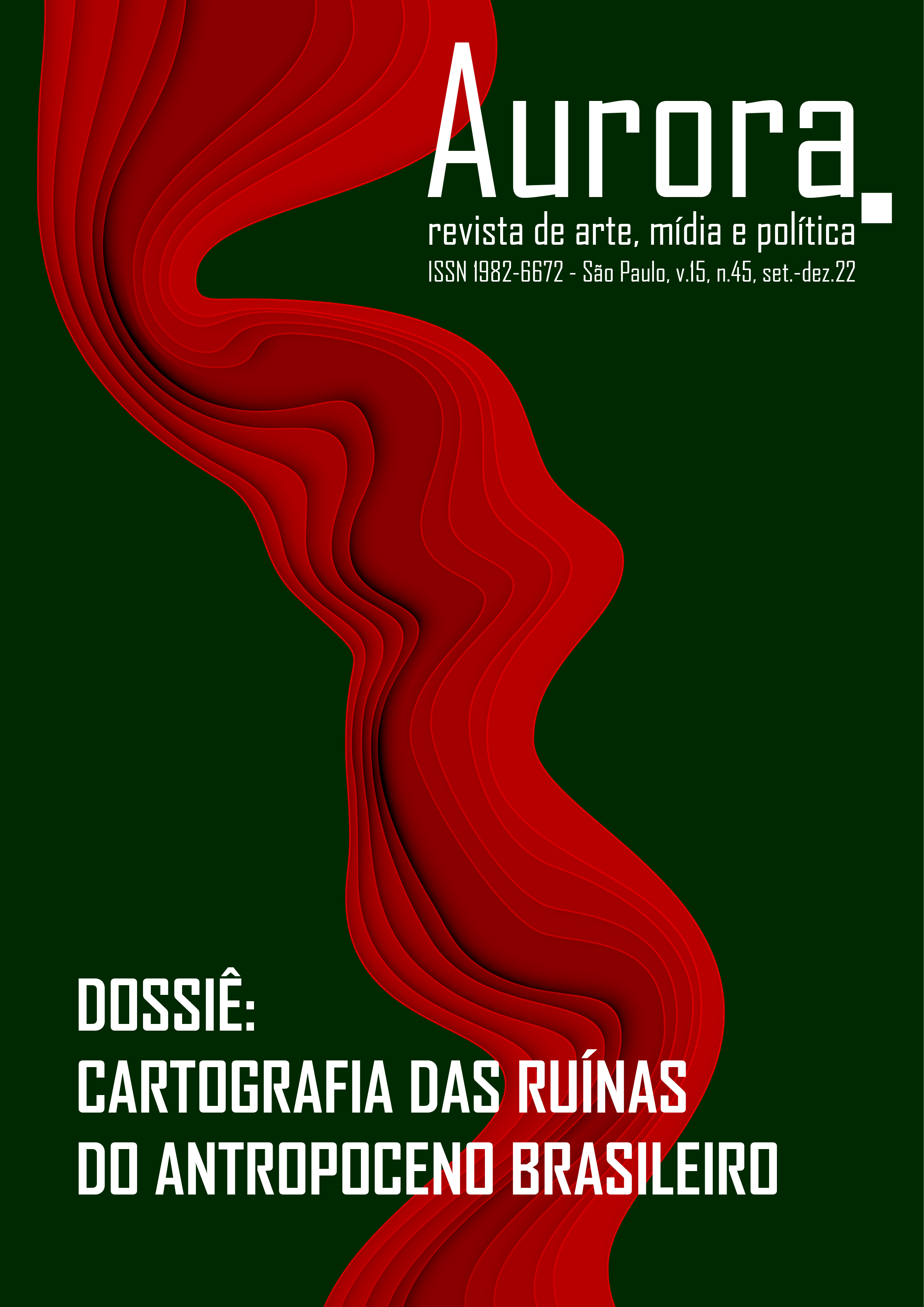Las múltiples temporalidades de la infraestructura
ciudades atómicas y la memoria de futuros perdidos
DOI:
https://doi.org/10.23925/1982-6672.2022v15i45p117-134Palabras clave:
Antropoceno, plantas de energía nuclear, ciudad atómica, mito del progresoResumen
Las plantas de energía nuclear, con su promesa de energía ilimitada y de bajo costo, son el arquetipo del progreso moderno. A medida que reconocemos los límites del progreso industrial y del capital basado en el crecimiento, los lugares donde el sueño se acabó, cuyos habitantes encuentran formas de vida en medio de la transición, ofrecen ontologías prácticas emergentes basadas en el mantenimiento, el bricolaje y la necesidad. A través de un estudio de caso de la ciudad atómica de Visaginas, en Lituania, este artículo aborda la cuestión de cómo hacer frente a las formas de vida que surgen en un contexto de agotamiento de la alta modernidad. Aquí, las infraestructuras operan como recursos culturales y materiales residuales para ontologías prácticas y para la construcción del mundo post progreso. Con base en una discusión sobre la estética política de la infraestructura, sugiero que su transición ontológica implica lo que Mark Fisher describe como la “memoria de los futuros perdidos”, un futuro anterior que, a través de los restos de conexiones materiales, tecnoculturas y memoria cultural, establece límites. y condiciones para formas de vida emergentes “post progreso”.
Citas
ANAND, N. A public matter: Water, hydraulics, biopolitics. In: ANAND, N.; GUPTA, A. and APPEL, H. (eds). The Promise of Infrastructure. Durham and London, Duke University Press, 2018, p. 155–172.
BALOCKAITE, R. Coping with the unwanted past in planned socialist towns: Visaginas, Tychy, and Nowa Huta. Slovo, 2012, 24: 41–60.
BAUBINAS, R. and BURNEIKA, D. Social Consequences of Closing the Ignalina NPP. Geografija, 2001, 37: 69–75.
BERLANT, L. (2016) The commons: Infrastructures for troubling times. Environment and Planning D: Society and Space, 2016, 34: 393–419.
BERMAN, M. All That is Solid Melts into Air: The Experience of Modernity. Brooklyn, NY, Verso, 1983. [Tudo que é sólido desmancha no ar, trad. bras. Carlos Felipe Moisés e Ana Maria L. Ioriatti. São Paulo, Companhia de Bolso, 2007.]
BROWN, K. L. Plutopia: Nuclear Families, Atomic Cities, and the Great Soviet and American Plutonium Disasters. New York, Oxford University Press, 2013.
DAWNEY, L. Figurationing. In: UPRICHARD, E.; LURY, C; FENSHAM, R. et al. (eds). Routledge Handbook of Interdisciplinary Research Methods. London, Routledge, 2018.
DAWNEY, L. Decommissioned places: Ruins, endurance and care at the end of the first nuclear age. Transactions of the Institute of British Geographers, 2020a.
DAWNEY, L. Dramatising deindustrialisation. In: PRICE, W.; Rhodes, M. and WALKER, A. (eds). Geographies of Post-Industrial Memory, Place, and Heritage. London, Routledge, 2020b.
FISHER, M. Ghosts of my Life: Writings on Depression, Hauntology and Lost Futures. Winchester, UK, John Hunt Publishing, 2014. [Fantasmas da minha vida: Escritos sobre depressão, assombrologia e futuros perdidos, trad. bras. Guilherme Ziggy. São Paulo, Autonomia Literária, 2022].
HARVEY, P. and KNOX, H. The enchantments of infrastructure. Mobilities, 2012, 7: 521–536.
HECHT, G. Being Nuclear: Africans and the Global Uranium Trade. Cambridge, MA, MIT Press, 2012.
HETHERINGTON, K. Surveying the future perfect: Anthropology, development and the promise of infrastructure. In: Infrastructures and Social Complexity. London: Routledge, 2016, p. 58–68.
JENSEN, C. B. and MORITA, A. Introduction: Infrastructures as Ontological Experiments. Ethnos, 2017, 82: 615–626.
JONES, B. M. (Com)Post-capitalism: Cultivating a more-than-human economy in the Appalachian Anthropocene. Environmental Humanities, 2019, 11: 3–26.
KIRKSEY, S. E.; SHAPIRO, N. and BRODINE, M. Hope in blasted landscapes. Social Science Information, 2013, 52: 228–256.
KOHN, M. Dreamworlds of deindustrialization. Theory & Event, 2009, 12.
LARKIN, B. The politics and poetics of infrastructure. Annual Review of Anthropology, 2013, 42: 327–343.
LARKIN, B. Promising forms: the political aesthetics of infrastructure. In: ANAND, N.; GUPTA, A. and APPEL, H. (eds). The Promise of Infrastructure. Durham, Duke University Press, 2018, p. 175–202.
MASCO, J. The Theater of Operations: National Security Affect from the Cold War to the War on Terror. Durham, Duke University Press, 2014.
PAPADOPOULOS, D. Experimental Practice: Technoscience, Alterontologies, and More-than-Social Movements. Durham, NC, Duke University Press, 2018.
PITKANEN, L. and FARISH, M. Nuclear landscapes. Progress in Human Geography, 2018, 42: 862–880.
RINGEL, F. Post-industrial times and the unexpected: Endurance and sustainability in Germany’s fastest-shrinking city. Journal of the Royal Anthropological Institute, 2014, 20: 52–70.
RINGEL, F. The production of indeterminacy: On the unforseeable futures of postindustrial excess. In: ALEXANDER, C. and SANCHEZ, A. (eds). Indeterminacy: Waste, Value, and the Imagination. Oxford, Berghahn, 2018, p. 68–88.
ROBBINS, J. Beyond the suffering subject: Toward an anthropology of the good. Journal of the Royal Anthropological Institute, 2013, 19: 447–462.
SCHWENKEL, C. (2018) The current never stops: Intimacies of energy infrastructure in Vietnam. In: ANAND, N.; GUPTA, A. and APPEL, H. (eds). The Promise of Infrastructure. Durham and London, Duke University Press, 2018, p. 102–129.
ŠLIAVAITĖ, K. ‘Homeland is where everything is for the people’: The rationale of belonging and _ citizenship in the context of social uncertainty. In: KNUDSEN, I. H. and FREDERIKSEN, M. D. (eds). Ethnographies of Grey Zones in Eastern Europe: Relations, Borders and Invisibilities. New York, Anthem Press, 2015, p. 107–122.
TSING, A. L.; BUBANDT, N; GAN, E. et al. Arts of Living on a Damaged Planet: Ghosts and Monsters of the Anthropocene. Minneapolis, MN, University of Minnesota Press, 2017.
Descargas
Publicado
Cómo citar
Número
Sección
Licencia
Derechos de autor 2023 Aurora. Revista de Arte, Medios y Política.

Esta obra está bajo una licencia internacional Creative Commons Atribución-NoComercial-CompartirIgual 4.0.











